Operation Cannonshot Memorial Tour 2018: After the failure of the Arnhem part of Operation Market Garden in September 1944, known as the Battle of Arnhem, the northern part of the Netherlands remained occupied by nazi-Germany. In the spring of 1945, the Western Allies launched several military operations to liberate the northern part of the Netherlands, two of them were Operation Cannonshot and Operation Quick Anger. To liberate the Dutch cities of Apeldoorn and Deventer, and the Veluwe, the high ground between these cities and Arnhem, Operation Cannonshot was launched on 11 April 1945. The 48th Highlanders of Canada crossed the IJssel from the east, a branch of the Rhine, between the villages of Voorst and Wilp. Wilp was the first village entered by the 1rst Battalion of the 48th Highlanders of Canada. During the liberation of Wilp, 19 Canadian soldiers were killed, including the commanding officer.
In April 2018, we took part in the Operation Cannonshot Memorial Tour. In our own Ford Jeep, together with other WWII vehicles, we partly followed the route the Canadian liberators took in april 1945, on route we visited several WWII memorials, such as the memorial at the hamlet Woeste Hoeve and the Dutch Field of Honour Loenen. We attended the memorial ceremony at the IJssel Crossing Memorial on the bank of the IJssel between Voorst and Wilp and the wreath-laying ceremony at the church of Wilp. The Highland Regiment Pipes and Drums performed at both of the ceremonies. The memorial tour ended at the village church of Wilp. The memorial tour and memorial ceremony were organised by the Groene Soos and the Interest Group Wilp.
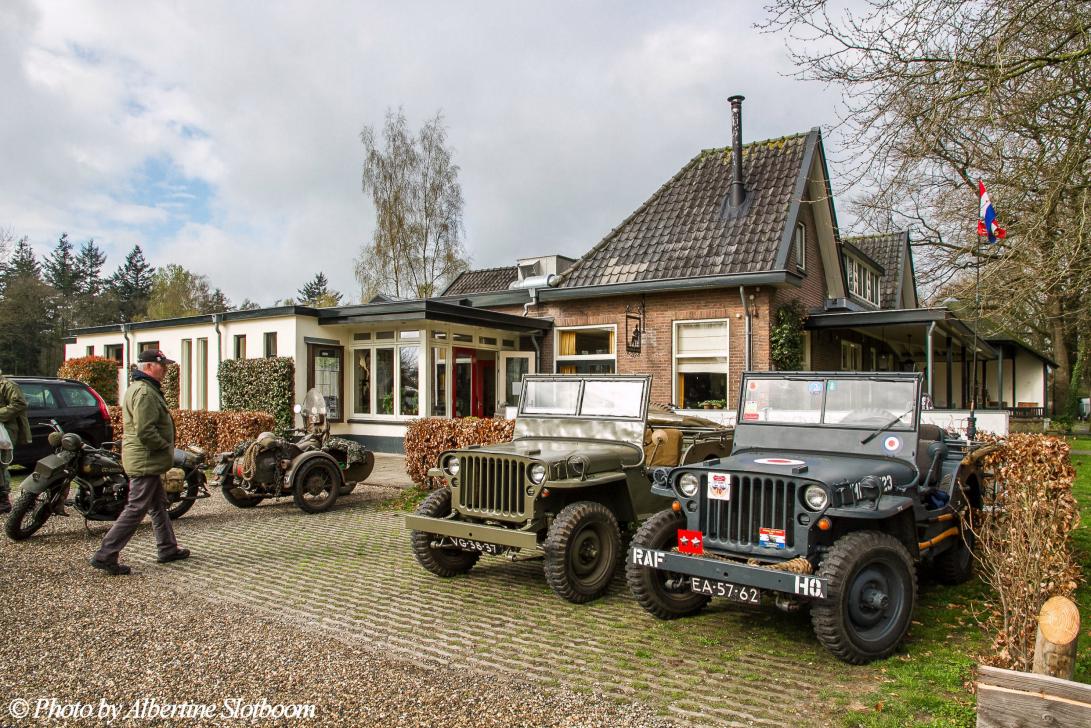
Operation Cannonshot Memorial Tour: In April 2018, together with our own Ford GPW Jeep, we participated in the Operation Cannonshot Memorial Tour. Operation Cannonshot was launched by the Western Allied forces on 11 April 1945 to liberate the Dutch cities of Apeldoorn, Deventer and the high ground between these two cities and Arnhem.

Operation Cannonshot Memorial Tour: In April 2018, together with our own Ford GPW Jeep, we participated in the Operation Cannonshot Memorial Tour. Operation Cannonshot was launched by the Western Allied forces on 11 April 1945 to liberate the Dutch cities of Apeldoorn, Deventer and the high ground between these two cities and Arnhem.

Operation Cannonshot Memorial Tour 2018: Driving our own 1942 Ford GPW Jeep on the hard-packed sand roads of the Veluwe. We partly followed the route our Canadian liberators took in april 1945. The Veluwe is a varied landscape of heathland, farmland, forested hills and shifting sands. The Veluwe is among the most beautiful areas in the Netherlands.
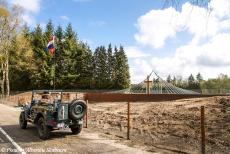
Operation Cannonshot Memorial Tour 2018: Monument at the Dutch hamlet the Woeste Hoeve. On 8 March 1945, just two months before the end of the war, the German SS executed 117 men on this spot. It was a reprisal for the attack on Hanns Albin Rauter, during the Second World War the Highest SS and Police leader in the Netherlands.
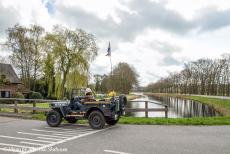
Operation Cannonshot Memorial Tour: Our own Ford Jeep crossing the Apeldoorn Canal during the Operation Cannonshot Memorial Tour 2018. After the successful IJssel crossing near Wilp, the soldiers of the 48th Highlanders of Canada and the Canadian Hastings & Prince Edward Regiment crossed the canal on 16 April 1945 to liberate the City of Apeldoorn.
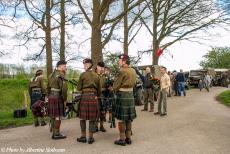
Operation Cannonshot Memorial Tour: The Highland Regiment Pipes and Drums was invited to support the remembrance ceremony at the IJssel Crossing Memorial on the bank of the River IJssel in Voorst near Wilp. The Highland Regiment Pipes and Drums is a Dutch Pipe and Drum Band, who support many Second World War remembrance ceremonies.
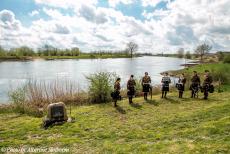
Operation Cannonshot Memorial Tour: The IJssel Crossing Memorial on the bank of the River IJssel, the memorial remembers the 48th Highlanders of Canada crossing of the IJssel during Operation Cannonshot in the spring of 1945. The Highland Regiment Pipes and Drums in the background.
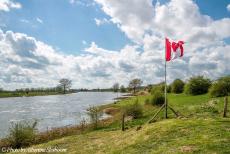
Operation Cannonshot Memorial Tour 2018: The Canadian Flag raised on the banks of the River IJssel near the village of Wilp. On this spot, the 48th Highlanders of Canada crossed the IJssel on 11 April 1945 to liberate the Dutch cities of Apeldoorn and Deventer, this infantry regiment also liberated the Veluwe.
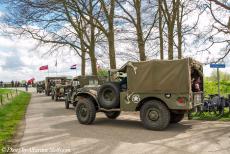
Operation Cannonshot Memorial Tour 2018: A convoy of military historic vehicles of the Second World War driving on the narrow dyke road between the small Dutch villages of Voorst and Wilp, passing the IJssel Crossing Memorial on the bank of the River IJssel. The historic military vehicle in the foreground is a Dodge, a military utility truck used during the Second World War.
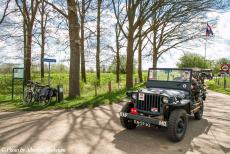
Operation Cannonshot Memorial Tour: Our own Ford Jeep during the Operation Cannonshot Memorial Tour 2018. The Jeep was produced by the Ford Motor Company in april 1942 and landed at Juno Beach in 1944, one of the landing beaches in Normandy, just a few weeks after D-Day. The Jeep is painted in Royal Air Force blue.
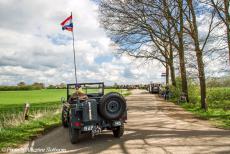
Operation Cannonshot Memorial Tour: In our own original Ford GPW Jeep driving on the dyke road from the village of Voorst to the village of Wilp, passing the IJssel Crossing Memorial, the WWII monument is situated at the foot of the dyke, on the bank of the IJssel, on the spot where the Western Allies crossed the IJssel in 1945. The IJssel is a 116 km long branch of the Rhine.
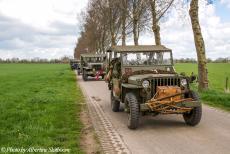
Operation Cannonshot Memorial Tour: About 36 military vehicles of the Second World War participated in the memorial tour, among them a Canadian Jeep. The Operation Cannonshot Memorial Tour and the Operation Cannonshot memorial ceremonies were organised by the Groene Soos, an association for historic military vehicles owners, and the Interest Group Wilp.

Operation Cannonshot Memorial Tour: Our own 1942 Ford GPW Jeep, together with several other historic military vehicles of the Second World War, surrounded by the flat landscape of the Netherlands. The vehicles are on the way to attend the wreath-laying ceremony at the Village Church of Wilp.
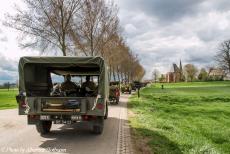
Operation Cannonshot Memorial Tour: The convoy of historic military vehicles of the Second World War on the way to the small Village Church of Wilp (on the right-hand side). Most of the vehicles, who participated in the memorial tour, were Willys MB Jeeps, a few Dodges and motor bikes, and only one Ford GPW Jeep.
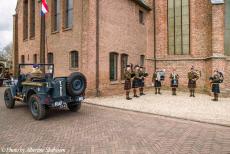
Operation Cannonshot Memorial Tour: While the Highland Regiment Pipes and Drums played, the convoy of historic military vehicles drove past the 11th century Village Church of Wilp. All the military vehicles, who participated in the Operation Cannonshot Memorial Tour, served in the Second World War.

Operation Cannonshot Memorial Tour: The Highland Regiment Pipes and Drums is marching through the village of Wilp, the historic military vehicles are parked on one side of the street. The members of the Pipe and Drum Band all wear a Regimental Tartan of their own choice to commemorate all the Scottish regiments.
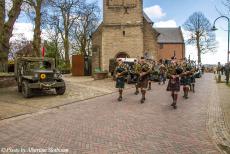
Operation Cannonshot Memorial Tour: The Highland Regiment Pipes and Drums in front of the Village Church of Wilp. In 1945, the church and the historic organ were severely damaged during the liberation of Wilp. In 2010, during the 65th anniversary of the liberation of the Netherlands, the Canadians made a donation to replace the organ by another historic organ.

Operation Cannonshot Memorial Tour: Our own Ford Jeep and several other military vehicles of the Second World War in front of the Village Church of Wilp. During the liberation of the village of Wilp on the morning of 11 April 1945, the commanding officer of the 1rst Battalion of the 48th Highlanders of Canada was killed near the Village Church by German shellfire.

Operation Cannonshot Memorial Tour: A plaque on the wall of the small village church of Wilp in memory of the 48th Highlanders of Canada, 19 soldiers of them were killed in and around Wilp during the liberation of the village, including the Commanding Officer Lieutenant-Colonel Donald MacKenzie. He is buried at the Holten Canadian War Cemetery.
